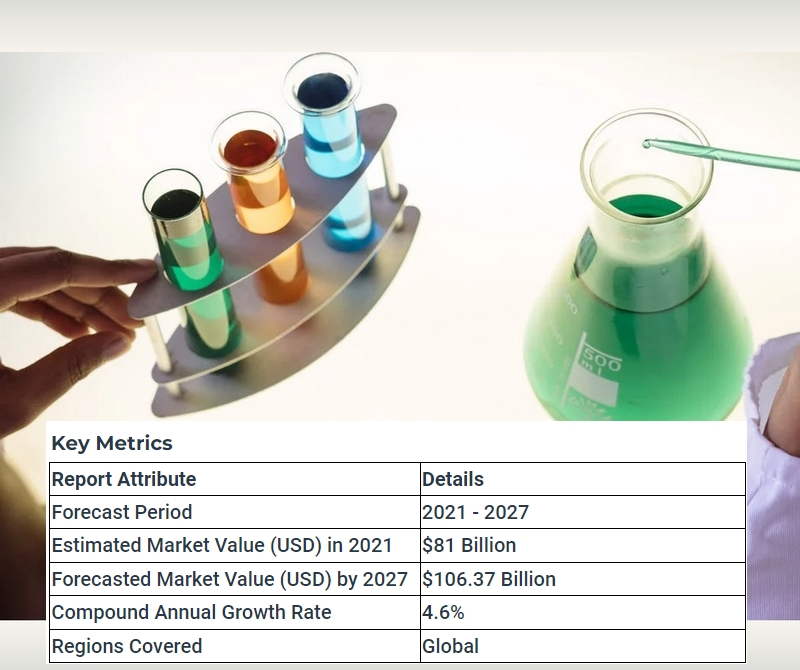Edson Perin
Demand for advanced and innovative solutions, such as self-administered medication delivery devices, is increasing in high-income countries, bringing lucrative opportunities to the pharmaceutical drug market. This is what the report “Pharmaceutical Packaging Market – Global Outlook & Forecast 2022-2027” points out, released this Monday, January 16, 2023, by ResearchAndMarkets.com. Experts predict a growth of 4.65% (CAGR or compound annual growth rate), from 2021 to 2027.
As illnesses have increased in recent years, including various types of flu, the COVID-19 pandemic, monkeypox and more, rising healthcare expenditures and growing consumer awareness of healthier lifestyles drive the sector. Due to the increasing prevalence of chronic diseases, growth in the biologics market and technological advances are expected to drive the pharmaceutical market. However, fluctuations in raw material prices, emerging markets such as newly developed drugs, and lack of compliance with regulatory standards are challenges to this growth.
The rise of virtual consultations is anticipating the growth of aluminum-based drug packaging. In high-income countries in North America and Europe, there is increasing adoption of virtual visits and electronic prescriptions, leading to a heavy reliance on home delivery of medications.
Home delivery of goods is one of the significant challenges for pharmaceutical packaging companies as customers are not aware of proper disposal of packaged products and materials, leading to substantial environmental impact. Due to this concern, aluminum packaging is one of the improved solutions to overcome this problem.

The study also shows that around 85% of the waste produced in healthcare operations, including pharmaceutical and medical equipment packaging, is not dangerous and, therefore, has the potential to be replaced by other ecologically correct and reusable alternatives, enabling significant cost savings. .
Many pharmaceutical companies are switching to sustainable packaging that uses recyclable materials and biodegradable plastics. Sustainable pharmaceutical packaging is expected to grow during the forecast period.
Counterfeiting – A counterfeit pharmaceutical product is deliberately and fraudulently labeled with respect to identity. Counterfeit pharmaceuticals can include products with the correct ingredients, the wrong ingredients, no active ingredients, the wrong ingredients with an inaccurate amount of an active ingredient, or fake packaging. The global pharmaceutical packaging market has witnessed a major challenge with the increasing incidence of counterfeit products.
As a result, many manufacturers in recent years have introduced various anti-counterfeiting features to combat the distribution of counterfeit pharmaceuticals. These anti-counterfeiting features include the use of thermochromic inks for labeling, holograms, QR code, RFID tags and more. Some innovations include child-resistant, elderly-friendly and high-barrier packaging, single-dose, multi-dose and special film.
Pandemic – COVID-19 has shown adverse effects on the global healthcare sector and thus has contributed to impede the growth of the pharmaceutical packaging market. The impact of COVID-19 on the pharmaceutical sector has included changes in demand, regulatory adjustments, changes in the Research and Development (R&D) process and supply chain restructuring.
In addition, trends such as industry slowdown, delays in approvals, modification of clinical trial methods, self-sufficiency in the pharmaceutical supply chain and variations in the consumption of nutritional and health products are expected as long-term impacts of the coronavirus pandemic. COVID-19 in the pharmaceutical industry worldwide.
During the pandemic, pharmaceutical packaging companies witnessed steady revenue growth in 2020. Major pharmaceutical packaging companies increased their production capacity to meet the increased demand for pre-filled syringes, blister packs, ampoules/vials, pouches, cartridges, containers and jars.
This was primarily due to an increase in demand for COVID-19-related drugs and vaccines. In addition, pharmaceutical packaging for biologics, sterile packaging, smart packaging, patient-focused packaging, cleanroom expansion, and more are expected to drive the global pharmaceutical packaging market in the long term.
The primary pharmaceutical packaging segmentation accounted for the largest market share of 70.20% in 2021 due to the growing demand for blister packs, vials, vials, ampoules, sachets, sachets and bags. Blister packs represent a significant revenue share of 35.23% in 2021 in the global pharmaceutical packaging market due to the high demand for prescription and non-prescription drugs/drugs, among which the demand for generic drugs is the highest among LMICs.
Although the pharmaceutical sector represents the largest share of the global market, a consistent increase in demand for blister packs contributes to its cost-effectiveness. The evolution from simple bulk packaging materials to ready-to-sterilize (RTS) primary packaging components and systems is the dominant trend in the primary packaging segment of the market.
Innovations in secondary pharmaceutical packaging include the development of child-proof (CR), tamper-evident (TE) carton packs, and cold-chain packaging. The secondary packaging segment accounted for 20.30% of the global pharmaceutical packaging market share.
Tertiary packaging is used for safe handling and smooth transport of products. Examples of tertiary packaging include plastic bags, shrink wrap and cartons. The growing e-pharmacy trend is likely to drive the adoption of tertiary packaging in the pharmaceutical packaging market. It is expected to grow at a CAGR of 3.96% during the forecast period.
Paper materials accounted for the highest revenue share of 39.36% in 2021 in the global pharmaceutical packaging market due to its growing demand in secondary and tertiary packaging, low cost and increasing focus on recyclable and eco-friendly materials.
Demand for paper-based packaging, both corrugated and folding, has increased across Europe in recent years due to its largest pharmaceutical market and largest exporter of pharmaceuticals. WestRock Company is a leading paper packaging manufacturer.
Plastics held the third-largest share in 2021 of the pharmaceutical packaging market by material segmentation. It is expected to grow at the highest CAGR of 4.94% from 2022 to 2027, driven by its increasing demand across all three types of packaging. Furthermore, plastics are widely used in packaging due to their versatility, flexibility and cost-effectiveness. However, due to its indecomposable properties and its prohibition of use for environmental reasons, as it produces a large amount of greenhouse gases, its use has been banned in several countries.
As a result, recyclable plastics are in high demand. The most widely used recyclable plastics in pharmaceutical packaging include PET, HDPE and PP, among which PET is the most commonly recycled plastic worldwide, followed by HDPE. Several governments and companies are developing initiatives to use recycled plastics as a packaging material for medicines and pharmaceutical supplies.
Pharmaceutical companies account for the highest market share of 48.18% in the global pharmaceutical packaging market by end-user segment. It is expected to grow at the highest CAGR of 5.10% during the forecast period.
The higher revenue share of pharmaceutical companies is because pharmaceutical companies are the main source for the pharmaceutical packaging market. As the demand for pharmaceuticals continues to grow, the need for packaging has also increased significantly.
The main players in the sector are Berry Global, Amcor, Gerresheimer, WestRock and AptarGroup. The sector is also attended by prominent players, some of which include ACG, Airnov, Borosil, CCL Industries and Drug Plastics Group.
North America accounts for 36% of the global pharmaceutical packaging market share. Growing pharmaceutical sales in North America are the main driver of the pharmaceutical packaging market in the region.
North America, in particular the US, will remain the largest pharmaceutical packaging market in the long term due to the advanced drug manufacturing industry. The US market is expected to maintain moderate growth due to an increasing aging population, robust innovations and increased consumer demand for sophisticated packaging.
Emerging markets such as Brasil, China and India are growing at the fastest rate, which can be attributed to their large population and demographic factors such as a growing youth population and higher life expectancy. APAC is estimated to show the highest growth of 5.01% during the forecast period.
The pharmaceutical industry is booming, especially in developing countries like China, India and Brazil, as well as in developed countries like the United States, United Kingdom and Germany. According to the India Brand Equity Foundation (IBEF), India is the largest global supplier of generic drugs. At the same time, the Indian pharmaceutical sector supplies around 50% of the global demand for various vaccines, 40% of the generic drug demand in the US and 25% of all pills in the UK.
For more information about this report, click here.



















